#. narrated by › lara croft
Explore tagged Tumblr posts
Text


Don’t wear without a belt
Also don’t explore with extra tight thigh straps.
#lara croft#autumn ivy#autumnivy#cosplayer#the bone collector#narrator#actor#costumer#amazon#alternative#cosplay#tomb raider
564 notes
·
View notes
Text
.
#tag dump.#. narrated by › derek hale#. narrated by › allison argent#. narrated by › ruby#. narrated by › oryan johnson#. narrated by › elizabeth swann#. narrated by › jack sparrow#. narrated by › lara croft#. narrated by › kyle crane#. narrated by › aiden caldwell#. narrated by › eritreah#. narrated by › damon salvatore#. narrated by › elena gilbert
0 notes
Text
Sophie's filmography
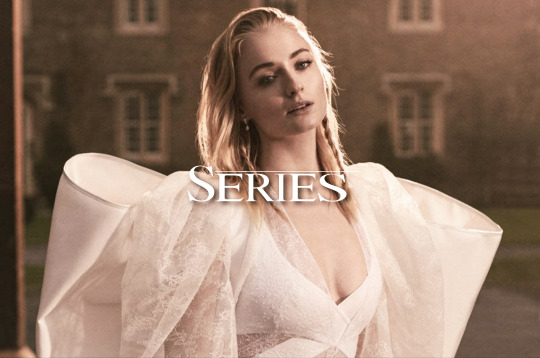
2011 - 2019 : Game of Thrones as Sansa Stark - Drama & Fantasy
2020 : Survive as Jane - Drama & Thriller
2020 : Home movie : The Princess Bride as Westley - Comedy & Fantasy
2022 : The Staircase as Margaret Rattlif - True Crime, Drama & Thriller
2022 : Story Bots : Answer Time as Lady Eleonore - Animation, Comedy & Family
2024 : Joan as Joan Hannington - Crime & Drama
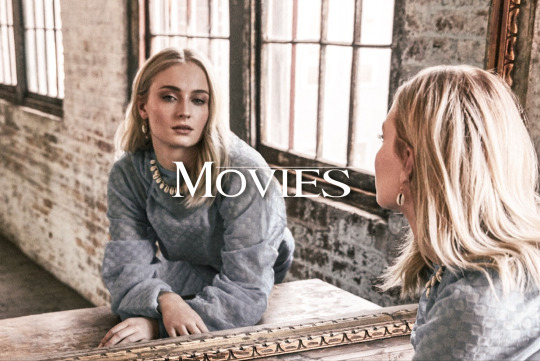
2013 : Another Me as Fay - Teen Drama & Thriller
2013 : The Thirteenth Tale as Young Adeline/Vida - Drama & Mystery
2015 : Secret Agency as Heather - Comedy & Action
2016 : X-men : Apocalypse as Jean Grey - Superhero, action & Sci-Fi
2018 : Josie as Josie - Drama & Thriller
2018 : Time Freak as Debbie - Comedy & Romance
2019 : Dark Phoenix as Jean Grey - Superhero, action & Sci-Fi
2019 : Heavy as Madeline - Drama
2022 : Every Last Secret as Penelope - Drama & Thriller
2022 : Do revenge as Erica - Teen Comedy & Dark Comedy
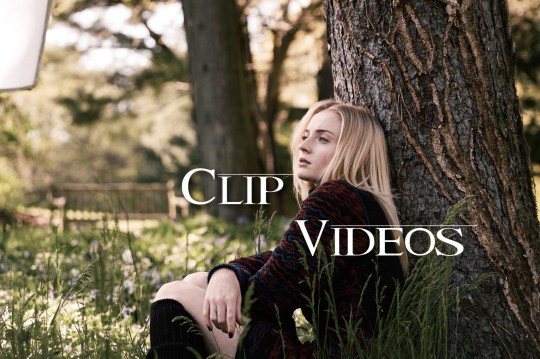
2014 : Bastille - Oblivion
2019 : Sucker - Jonas Brothers
2020 : What a man gotta do - Jonas Brothers
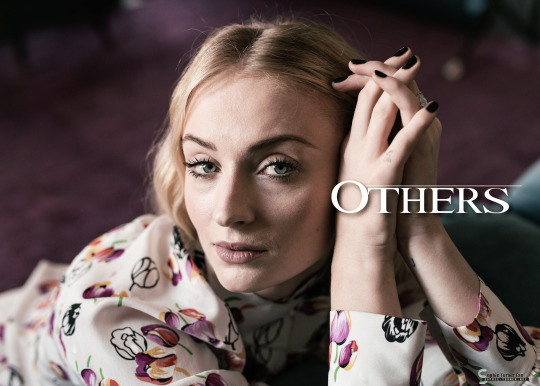
2013 : ‘The Girl in the Mirror’ - Narrator (audiobook)
2014 : City of Heavenly Fire by Cassandra Clare - Narrator (audiobook)
2016 : The Night Before - Mr Burberry & QG
2016 : Powershift- Documentary
2017 : Game of Thrones Conquest and Rebellion as Sansa Stark
2019 : Our Journey connected - Louis Vuitton
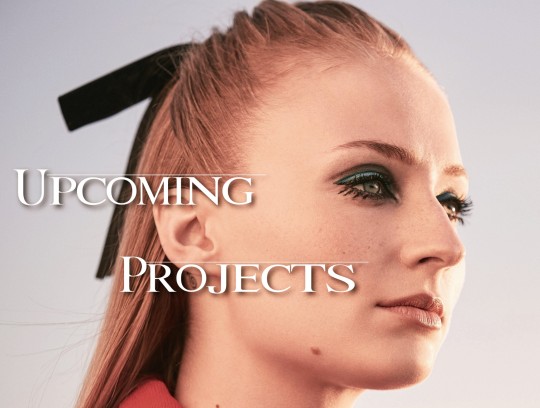
The Dreadful as Anne - Gothic Horror (postproduction) - movie
Trust as Lauren Lane - Psychological thriller (post production) - movie
Haven as Zara - Heist thriller (post production) - tvseries
Cloud One - Science-Fiction (preproduction) - movie
Tomb Raider project as Lara Croft - action/adventure (preproduction) - tvshow
All the pictures are edited by myself.
39 notes
·
View notes
Text
"The Byronic hero, incapable of love, or capable only of an impossible love, suffers endlessly. He is solitary, languid, his condition exhausts him. If he wants to feel alive, it must be in the terrible exaltation of a brief and destructive action."
— Albert Camus, The Rebel
Fiction is often the pill case for revolution, an outlet providing its narrator a means for advocation under the whimsical façade of fairies and dragons. C. S Lewis, author of the Narnia Chronicles, presents a ‘supposal’ (Klein, 2023) for the demonstration of Christianity within the magical realm, his faith guiding the four children through ‘the other’ (Nero, 2018) and presenting a reality where the Neoplatonic ‘Good’ trumps all who oppose it, Western societies ideals of social conduct influencing and ultimately conquering the new world. While fiction can be read as a simple escape from the mundanity of modern capitalist structures, it is its separation from our common world that makes it so fulfilling to engage with, frequently using the readers' immediate environment and shared comforts as a foundation to develop its image; Apocalypse as a genre (its Romanised translation meaning Revelation), came to be via the first eschatological texts written by Jewish-Exilic prophets between 200-165bce, and provides an immediate substructure for modern apocalyptic books, Tv shows and Movies such as The Last of Us (2023-), The Walking Dead (2010-2022) and many more widely adored pieces of media. With the genesis of the apocalyptic genre rooted within the catastrophic antisemitic acts of Late Babylonian reform, there is a palpable consummation between social histories and religious allegory, a trend carried throughout history with almost all apocalyptic texts, whether presented through the threat of the Spanish Armada In Webster’s ‘Duchess of Malfi’(1613) or Stoker’s reflection of public hysteria surrounding the fallen woman (The Fallen Woman, 2015) and the colonial guilt (Ilott, 2019) of the fin de siècle in ‘Dracula’(1897). In an ever-growing landscape reliant on technological advancements, there’s ultimately a far greater accessibility to such media, both moral conduct and educational improvements throughout history allowing modern civilization to adapt these tales to a varied representation of the genre for individualist satisfaction. Within the excitement of infinitesimal representations of leads and anti-heroes, a prevalent theme has begun to emerge within the apocalyptic genre, one that is intrinsically linked to the trivialised internet term ‘DILFism’, referring to the generalised attraction towards or for exclusively older men within an overwhelmingly female audience of a significantly younger age. These often white, conventionally attractive older men are a significant drive in younger female audiences engaging in apocalyptic works that have conventionally been geared towards male interest, diverting the gaze often adapted for male interest (such as in the Tomb Raider games and films with the ultra-feminine and beautiful Lara Croft) to a shockingly attainable yet handsome father figure, there to be digested by audiences sexually while posing no threat to his young viewers by appearing adorably platonic. This Leading Man acts in innuendo, appealing to the taboo intrigue of young sexuality and providing a pacifying pathway for the viewer to enact her fantasy upon him, whether that be sexual or fatherly. While this trope could easily be banished to the realm of misogynistic irrelevance such as the vampire craze of the early 2000s was for its overwhelming digestion by young female audiences, the overlap between male-centered apocalyptic action media and its newly claimed female audience presents parallels to social metaphors that reflect the (aforementioned) Prophets of the Old Testament. The emergence of this new Byronic Hero within modern apocalyptic media represents modern fears, a religion on which an under-represented diaspora can exert a mythological metaphor. Despite their undeniable good looks, the men at the center of the female gaze within the apocalyptic genre give a deeper insight into the shortcomings of establishment, and in their placement within the end of the world, such figures can help guide a displaced generation into the promise of a better future.
Early 2000s media brought with it a wave of seemingly irreverent internet terms, which when used to describe the emerging cliques and fandoms for contemporary literature and films such as Twilight and The Vampire Diaries, saw an overwhelming demonisation of its content. Any misogynistic nuance was dissolved when considering the types of media being slated, internet forums and websites such as Kiwi Farms and Tumblr established for the sole purpose of slating media directed towards young, female audiences in the name of ‘Cringe Culture’. Where girls reading Stephanie Meyer and choosing to be team Jacob or Edward was the epitome of hysterical vanity, the same penalisation was not shown towards male-catered media, fights and deaths over football teams honoured as war victories as girls received insult over fandom blogs and posters on walls. While criticism of female-catered media is certainly justified in many respects (whether that be the glorification of eating disorders, negative body image, or the inherent controversy of consent between a 17-year-old girl and a 200-year-old vampire), chauvinist reactions to the female gaze prevailed, hence why as society liberalised the boundaries between gendered content (largely through the extensive piloting towards gender expression by feminist groups and non-binary protest), the leading man, our projective, father Byronic hero becomes the epitome of revolution within the segregated world of media consumption. Opinions, often held by men under the internet-slag terms ‘Incel’ or ‘Lolcow’, offer the opinion that the shared interest in these apocalyptic father figures by both men and women is inherently Freudian, that sexual drive and colloquially termed ‘daddy issues’ is the sole aspect in the consumption of male media by female audiences, inferring a shallowness to girl’s nature as they attempt to gatekeep. While there is irrefutable evidence of women being attracted sexually to the characters at the forefront of the argument, it holds no exclusivity; within these fantasy realms, physical attributes gain a certain irrelevance and whether battle-scarred or zoomorphised, each carries a similarly adoring audience. Within a society that values physical appearance so highly, the wastelands of an apocalypse offer the opportunity to alleviate the social pressures of conformity and the standards of beauty. With an estimated 8.6% of women suffering from disordered eating patterns (more than double the men affected), the survivalist landscape of a zombie apocalypse where self-preservation dominates institutional conventions becomes an unexpected comfort, a safe and Gothic green world upon which to live out the fantasy of escaping debilitating illness. With guides such as the war-torn Daryl Dixon or Rick Grimes from AMC’s The Walking Dead providing for you in this primitive, romanticised escape from your mental illness, it is no wonder so many girls seek comfort within the desolate apocalyptic landscape. Apocalypse here serves as an anecdote to a social structure dictated by advertising, women accounting for 80-90% of the $500 million beauty market fundamentally run by men. To find a man willing to accept you irrespective of looks, while depressingly vain when acknowledged, is undoubtedly attractive, affording viewers to see themselves as a woman worthy of survival while living in a society informed by looks. The Wasteland offers the ultimate validation for an impressionable young audience and finds a female majority following his character where the other sex finds it hard to relate, gendered advertising stretching rarely to male discredit as it does with women.
The promise of valued character over physicality is not the only unexpected comfort to come from the man at the forefront of the apocalypse; much of the character-archetype's allure comes from his ability to resolve crises and act in line with Western ideals of morality. Regardless of whether he has killed before or enjoys the violence of the landscape, he miraculously only harms those who rebut the American Dream, in many cases actively trying to restore it through seeking cures to outbreak or establishing towns on which to build a new, cleaner society. The congruence of societal reflection seen within all historical Apocalyptic fantasy media becomes apparent when considering recent social histories within the audiences' own lives. Many have lived through tragedy, viewers relating to fears of the pandemic, the prospect of war and its homely presence since the nuclear threat of the 1980s, and environmental meltdown a certainty at the hands of corrupt Machiavellian leadership. To see reality nullified and mythicised through the lens of fantasy makes a game of real fears, control passed to a righteous leader that works only for the common good. The control this lead plays in the survival of the apocalypse is perhaps his greatest attribute and, where his authority would be considered threatening in the current reality, only furthers his moral good within the ‘othering’ of Gothic apocalyptic fantasy; Joel Miller, the lead male character in the video game/TV series The Last of Us, is a prime example of the unsuspecting yet powerful virtue of the archetype. In his reluctant quest to move a young girl (Ellie) across the wasteland of zombie-ruined America, he presents an unfaltering physical and mental strength when facing those intent on harming the child. He is family-oriented, seeing something of his late-daughter in Ellie, installing such a strong, platonic bond between the two that he becomes the ultimate guardian, and audiences are assured that no harm should ever come to the child as long as she is with her adopted father, Joel; the transitional period between teen-age and adulthood is a turbulent time developmentally, The Pew Research Institute assessing that fatherly relationships with their daughters are significantly lower in civility than they are in mother/daughter relationships. Joel and characters like him provide an alternative, his nature an accumulation of desired or lost parental relations, not only installing him with the control a parent possesses but elevating the responsibility of the emerging adult viewer as they find comfort in rewritten and fictitious paternal relations. Joel is unfalteringly omnipotent, omnipresent, and benevolent towards Ellie, positioning his character in a prophetic light, deifying him through moral and physical superiority that seems worthy of worship, just as girlish fandom does within fan pages and forums. His fatherly devotion establishes zero sexual threat which, in a society where 15 million girls ages 15-19 have experienced rape and sexual violence, offers a reprieve from the everyday terror of assault, his character going as far as to hunt down and sadistically eliminate those who attempted to enact such abuse upon Ellie. Where indignation is a reality expected for many women emerging into adulthood and with ubiquitous fears of societal and environmental disestablishment, a character, morally grey as the ‘green world’ has allowed them to become, adheres to the scriptures of idealised, Christian virtue, allocating the same messianic image onto the aging survivalist as Aslan provided in C.S. Lewis’ Chronicles. Their characters are easily relatable, the main drive of the archetype is to reestablish a dignified control in an otherwise unstable landscape, a reflection of the transitional state of the age and location of his audience within a faltering capitalist civilisation.
The perfect image of this hero is disparaged only by his age and appearance, which, within a topography so ruinous as in the realm of fantasy, often only deepens his appeal; Domonique Lestel from the Edinburgh University Press supposes that young adult audiences reflect their opinions of the state of the common world into the media mythologies, meaning that romanticising the downfall of Institution makes it easier to digest, especially for those just entering a chartered marketplace disguised as the ‘9-5’. Through creating a limerent and metaphorical relationship with the characters that represent the shortcomings of society, it is easier to categorise reality in an attractive regard: falling in love with the principled ‘monster’ navigating the end of the world makes one’s journey a lot more palatable. Leaders of the Pagan faith endorse similar techniques of self-soothing and discovery through spiritual rituals such as shadow work, where a subject attempts to converse with the Freudian, psychoanalytic ‘Id’ with the aim of self-reflection and ultimately deliverance from repressed fears and desires stifling life’s natural transitions. Through the discovery of personal discomposure, one can reframe anxieties within superficial terrain, allowing audiences in such a landscape of apocalyptic fiction to transgress fear into desire. Indications of transgressive reframing are found throughout literary history, similar reflections of the female gaze can be witnessed through Lucy Westenra’s actions in Bram Stoker’s ‘Dracula’ (1897); in her somnambulic state, Lucy finds herself unchaperoned in the garden late at night, called to the wolf-ish form of Dracula through an uncharacteristic sexual appetite, actions which would ultimately lead to her untimely and violent death. Lucy’s representation as the ‘femme fatale’ within the epistolary novel was a pasquinade by Stoker, mocking contemporary views on the Fallen Woman and implicitly addressing the institutions upon which he as an author was extradited for his social politics. Through the lens of the Gothic, which as a genre, rests parallel to apocalyptic fantasy, the taboo is far easier indulged in, its separation from reality making the unknowable known and the offensive, satire, all containing still the knowledge that the text's themes are simply a facade held against the contemporary landscape. Our attraction to the hazy morals, animalistic forms, and violent delight of the apocalyptic male archetype is nothing more than a handsome way of exploring feared desire, whether that be sexual or in virtue, born from discomfort within the modern world with a value likened to religious practice, ancient or reformed.
With women often subject to the violent scapegoat of male-catered media, the stereotyped innocence of femininity is abolished when faced with the Western world’s destruction. It's unlikely that the shock of 19th century ‘flaneur-ish’ tropes depicting the slaying of the vicious, voluptuous, and ‘Fallen Woman’ with teeth lining her Vagina have vanished within the mindless violence of the modern slasher flick. Within the land of the undead, there’s an established law that human, moral or otherwise, boasts an absolute right to life above their late opposition; where the monster finds its origins in the misogynistic depictions of liberated women, the gleeful attitude towards the ‘boogeyman's’’ demise is perhaps a rather depressing extension of those same disparaging views towards, the colloquially and improperly termed, ‘fairer sex’. Women infiltrating these male-dominated spaces such as video game fandoms set within the apocalypse summons similar, but most certainly more trivial, trepidations as suffrage installed within the turn of the industrial century. The same threat to authority men faced in the political sphere during the late reign of Victoria is reproduced through retweets and dislikes, writers of modern apocalyptic media reframing institutional, often misogynistic tropes to seek a wider audience for capital gain, leaving many men stuck in the conventions of old to feel displaced themselves within ‘incel-ish’ apathy towards change. They find themselves unable to find the Femme Fatale represented within the media, disallowing an outlet to see women suffer nonsensically as was common up to as late as the mid-2000s (‘I Spit on your Grave’ [2010] being a continuously remade and adapted film that sees the liberation of its leading women to become a subplot to non-con/rape fantasy). The lead-male archetype is more than just a pretty face and a pat on the back for his audience, as his presence within the media is discouraging fantastical depictions of sexual assault and violence towards women for male satisfaction: his nonchalance and undiscriminating violence or absolute devotion towards social change add something of a Byronic hero to the framework of his media, providing a role model for young men, as well as an incentive to engage for women. The success of his character has lent itself to a lesser production of sadistic, prejudiced, and pornographic material influencing the impressionable generation, the irony of his place within a desolate, fictional society creating an antithetical impression on the reality of those who digest his plot.
The joy of seeing oneself accepted within celebrated media is an undisputable joy and the lessons one inadvertently learns through the exploration of a fictional narrative can uncover subconscious truths about the very foundations of society. In a world of strict binaries that install obtuse depressions and fears surrounding the transgressional stages we as a species collectively face, a character who holds a vicarious command over his landscape is a lot easier to adore than those with influence within reality, the fallible nature of his actions and desires forgivable through his distance from reality. Yet, it is his ability to collate the diverse nature of humanity that shows his audience a fairer, more accepting reality is possible, his bringing together of opposites through fandom blogs such as the one you are on currently, a much-needed reprieve from the segregated nature of our current political landscape. In a world of dog-eat-dog, the leading moody, fallible, scarred, violent, caring, volatile, sullen, moral, courteous, and devoted survivalist holds out his arm and holster to a new generation of isolated but hopeful youths to grab a hold on.
6 notes
·
View notes
Text
halloween costumes i need to wear and i will not let myself die until i do wear them for halloween
muddy trent reznor from woodstock 94, bonus if i have the opportunity to perform the whole tracklist VERY badly with a cheap karaoke box and a kids guitar for shits and giggles
lara croft
ellie williams
a quartet for sex dwarf by soft cell - the narrator, dumb chauffeur, sex dwarf and a disco dolly. too freaky? idk but creative i think
vampire obv but what we do in the shadows kind
second attempt at fight club duo/trio cuz this year lowkey failed
kesha
chappell roan. ok enough artists
death <3
random ass wig and clothes and gaslight ppl into for sure knowing the character even tho i am not dressed as anyone
idk
5 notes
·
View notes
Text
an independent, private, highly selective & canon divergent portrayal of the unreliable narrator PATRICK BATEMAN from AMERICAN PSYCHO. a study into the true depths of narcissism, acceptance of who he is, experiencing the joy of murdering those who belittle him, not knowing what is real and what is not, not wanting to stop his anger and serial killer urges. medium to slow activity. est. 14th june 2023. rebooted october 2024.
HEAVILY AFFILIATED WITH: @harleqin, @belayadeath, @gothampire, @spinwebs, @matryochka
THEMES THAT WILL BE PRESENT ON THIS BLOG INCLUDE: violence, drug usage & drug abuse, (mentions of) cannibalism, gore, sexual themes, sexual suggestions &, psychopathic murder. non-mutuals, minors, & personal blogs do not interact.
icons credit goes to @ninjacommissions.
business card self-image. mirror . prompts. bateman family. georgia. lara croft.
2 notes
·
View notes
Text
Lola Bunny in the comic books
I’ve discussed at length my views and opinions about Lola Bunny before (https://tymime.tumblr.com/post/174484746321/lola-bunny-is-one-of-animations-more), but something I’ve been wanting to really dive into was her sporadic appearances in DC’s Looney Tunes comic book series in the late ‘90s and early 2000s.
I think these are the most overlooked and underrated depictions of Lola ever, and actually very much key to understanding her personality, history, and potential. The trouble is, I’ve been waiting many years for someone to scan all the issues with her in it. But back in the day, I had issue #92, and when I read the Lola story within, I didn’t even blink. The basic premise of most of her stories is a weird one, but it somehow works. Her job is to deliver pizza. But she delivers pizza to gods, monsters, and other supernatural beings, traversing dangerous landscapes, fighting off viscious wild animals, and generally taking care of business. So like, when I was 13, it didn’t even occur to me that this was at all unusual. Of course she’s a kick-butt action girl. Why wouldn’t she be? What else would she be? I had seen Xena. I watched cartoons with strong female leads. I didn’t even have to think about it. There wasn’t any doubt in my mind that Lola could be more than a sports-obsessed, one-dimensional teen fantasy. It actually baffles me when I see anyone suggest otherwise, like the director for Space Jam: A New Legacy did. As if she wasn’t always the tough, proactive, heroic type. Of course Lola is an Amazonian warrior.
But let’s actually look at her first appearance in the comics, after the Space Jam graphic novel, in issue #60, 1999 (why it took three years for this to happen I can’t guess).
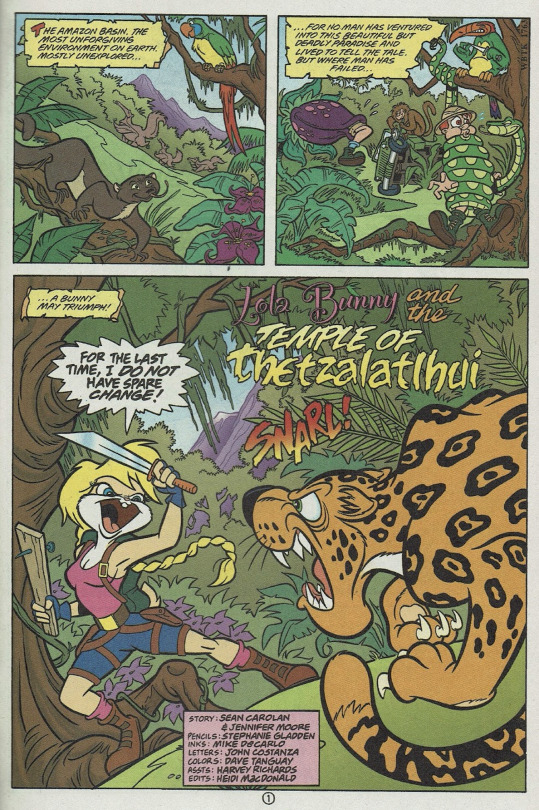
Right off the bat, we see Lola fighting off a jaguar with a machete and a board with a nail in it. The narration implies that a woman would do a better job at exploring and surviving the South American rainforest than a man could. I’m all here for it. It’s also an obvious parody of Tomb Raider and Lara Croft- probably because of the similarity between their figures, which for some reason people wouldn’t stop talking about for about two decades. While I haven’t played those games myself, I’m sure there’s much more to it than that, and it’s kind of a relief that we’re finally over it.
Something that these comics do well is give Lola additional quirks and traits. This first story does it straight away:

Apparently Lola has no sympathy for panhandlers. I’m not sure how I feel about that, since that sort of attitude often extends into dismissing homeless people who can’t get jobs for one reason or another, but hopefully Lola isn’t as black-and-white about the issue as she seems here.
At first it seems like a straightforward parody of temple-raiding adventures, à la Indiana Jones and even Ray Harryhausen movies, but then comes the twist:

Nearly all these stories follow a similar format- Lola has to deal with nasty aggressive demons and beasts to deliver a pizza from Machu Pizza (get it?), and she doesn’t break a sweat. I’m not sure how the writers (kudos to Sean Carolan and Jennifer Moore) came up with the idea, but it’s incredibly original and inspired and I’m glad they ran away with it.
Her next appearance in issue #71 is unfortunately a bit of a step backward, seen here portraying a parody of Daphne from Scooby-Doo, but I suppose there wasn’t anybody else available.
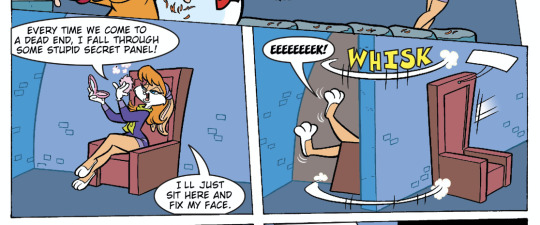
Luckily she goes right back to pizza delivery soon afterward in issue #76 (albeit nearly two years after the first time).
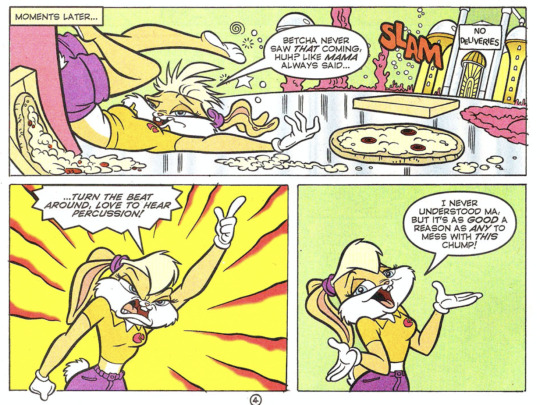
Apparently Lola’s mother was a fan of a ‘70s soul/disco singer named Vicki Sue Robinson. It’s weird randomness like this that makes these comics special, I think.
Another aspect about this depiction of Lola is that she shows just as much sharp wit, quick thinking, and cleverness that any good trickster should have- just like Bugs. And yet, she’s not just a carbon copy of Bugs, as it should be.
We also get a glimpse of Lola’s past in issue #80:
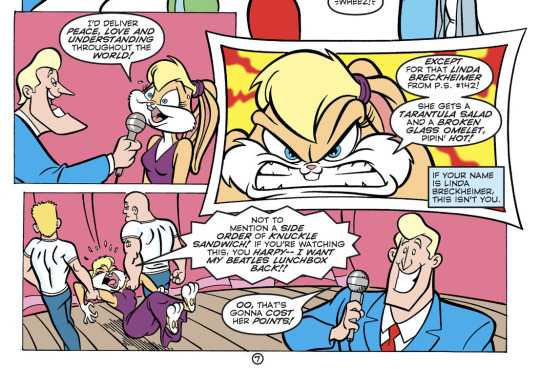
Apparently she’s a Beatles fan, which is always cool.
As I said, I had issue #92, completely out of context, but I caught on to the premise immediately nonetheless.
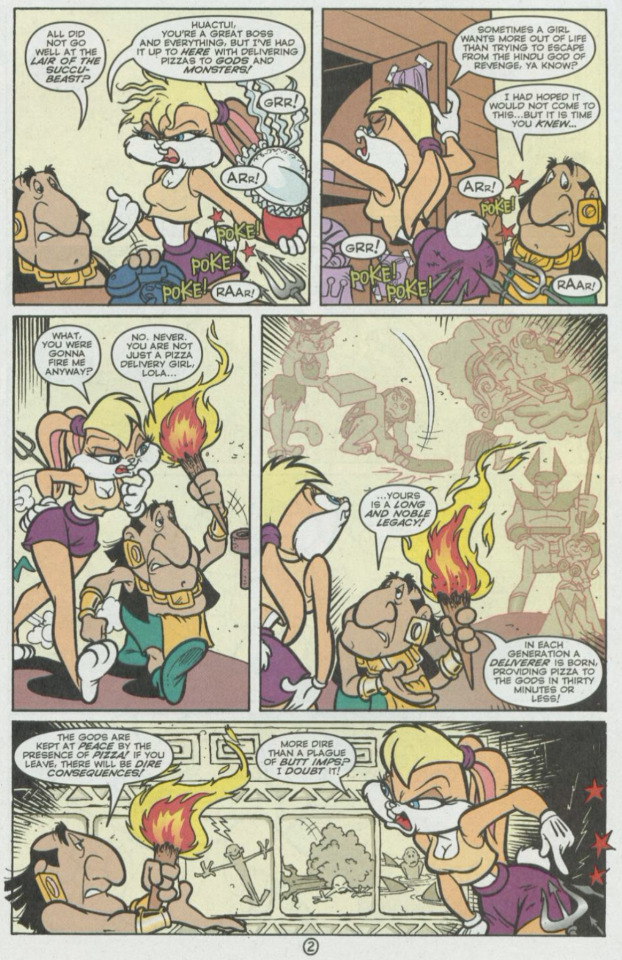
Here we learn that Lola is actually part of some legendary lineage, which prevents the gods from starting a war with each other. Sounds like a pretty big deal. Lola is fed up with all this nonsense, so she quits her job and starts working at a clothing store. I think this exchange speaks for itself:
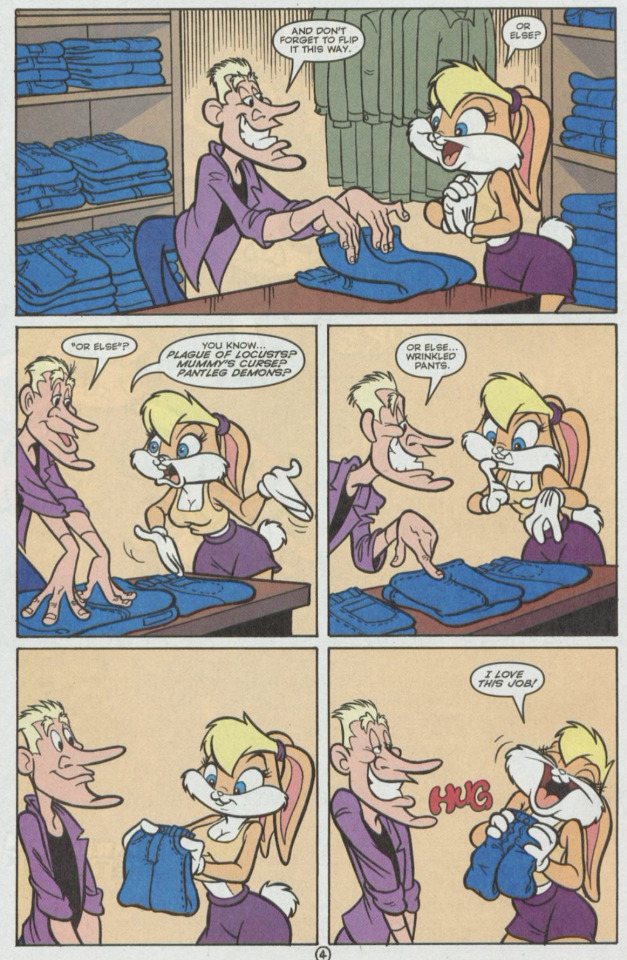
Eventually, however, she gets bored of nothing happening, and nobody else can deal with the mythical creatures like she can, so she returns to Machu Pizza with newfound confidence.
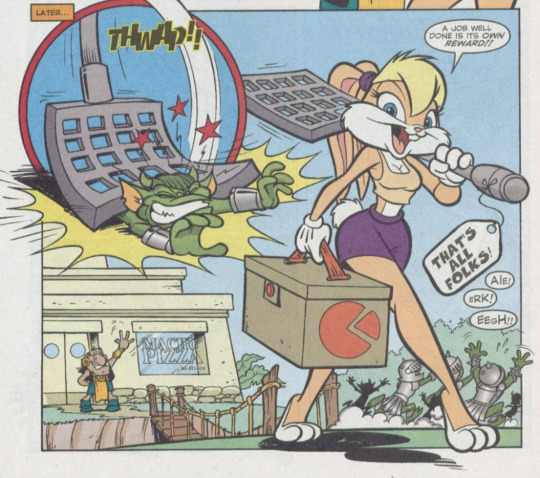
I think this is great stuff. She doesn’t put up with any guff.
Unfortunately, that’s the last of the pizza delivery stories, and it’s a shame there are so few of them, because it’s quite possibly the best material Lola ever had. I think more than anything it represents Lola at her fullest, and shows how much potential she has to be a regular character, instead of someone who just shows up every now and then, only to be reinterpreted once again.
Lola also wouldn’t make another proper appearance until 2011 in issue #203, only making background cameos in the meantime. This story- which is all about roller derby- is a bit underwhelming in comparison to her older comics. Sure, her sportiness comes into play for the first time since Space Jam (weirdly enough, considering that’s what she’s best known for), but she doesn’t get to do very much. There are good moments, though:

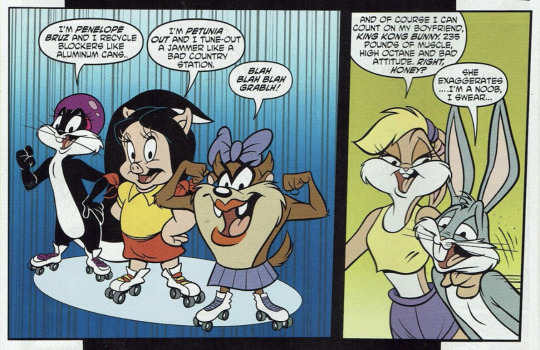
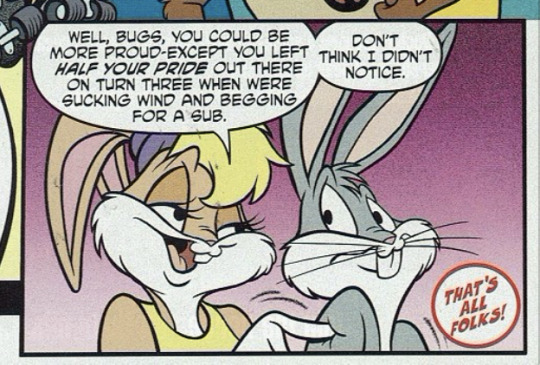
I’m into it. (The first panel implies Bugs and Lola knew each other in junior high/middle school, which is an interesting tidbit. It contradicts how they’ve never seen each other before in Space Jam, but Looney Tunes has never been much for continuity anyway.)
And that’s it for stories focused on Lola. From then on, her appearances are brief and insubstantial. In issue #220, she’s only in a few panels as an angry police chief.

In 2017, she appears in a Star Trek parody in issue #239, playing the Lt. Uhura part, and is essentially just as limited.

In 2019, she returns as a basketball player, and still doesn’t do much. They’re obviously trying to make her look more like she does in Space Jam, but no attempt is made to make her a main character.

Her most recent cameo is in 2023’s issue #269, which suggests that she won an award for journalism of all things.
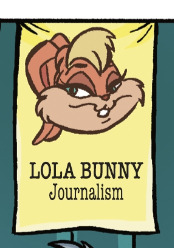
(EDIT: This might be a reference to her cameo in Tweety’s High-Flying Adventure, where she appears as a news anchor? That’s a pretty deep cut, if that’s the case.)

And that’s it. Outside of Space Jam: A New Legacy and its graphic novel adaptation, there really hasn’t been very much OG Lola Bunny media at all. (Slight update: Lola appears in issue #281, using her New Legacy model. She appears on the cover, and plays volleyball for a few panels, along with several other lesser-known female characters, but that’s all.)
In fact, the largest amount of screentime Lola ever gets is in Baby Looney Tunes of all things. That’ll be another blog for another time, when I finally finish watching that series, and it probably won’t be very long.
Other than that, Lola appears in three video games: Bugs Bunny & Lola Bunny: Operation Carrot Patch (the only time her name was in the title), Looney Tunes Racing (where they actually ramp up the whole “girl power” thing to Nth degree), and Looney Tunes: Space Race. She has minor roles in the webtoon Dating Do’s and Don’ts, and in Tweety's High-Flying Adventure. She has one cameo, and two featured episodes in New Looney Tunes- and only one of ‘em portrays her as smart trickster. She’s a main character in Bugs Bunny Builders, but her personality’s been reduced to a generic perky girl, although they at least refrain from making her stupid again. I actually like this show, though.
So why is this? Why do people struggle with writing for Lola anyway? It doesn’t seem so hard. The whole trouble is almost everybody seems to have a different perspective of the character, and I can’t figure out why. It seems pretty straightforward to me- she’s good at sports, she’s smart, she’s strong-willed, and doesn’t like being pushed around or not taken seriously. This is a personality type that’s been done before, in every genre. So what’s the deal with Lola? Why do people think she’s terrible or needs “fixing”? It doesn’t help that most of these comics are long out of print, hard to collect, and they’re not given much attention in the first place. They seem to be best known for starting Dave Alvarez’s career in Looney Tunes projects.
I suspect there’s not only a big wad of sexism involved, but also a general resentment towards Space Jam in general. The whole “how do you do fellow kids” aspect of that movie has dated it, I’ll admit, and I never took the whole hip-hop Looney Tunes thing that was going in the late ‘90s very seriously, even when I was a kid.
But that shouldn’t mean Lola should be dragged into it. Sure, the way they handle the character isn’t flawless- she literally comes out of nowhere, with hardly any proper introduction at all. We have no idea who she is or where she came from in the movie, and we probably never will. Her independent, self-reliant traits are a bit undermined when Bugs has to come to her rescue, briefly turning her into a damsel-in-distress. It’s not perfect, but then again, I’m not sure how else Bugs was going to become her boyfriend in the screen time available.
Why this makes people hate her or even see her as sexist, I can’t imagine.
She’s also one of the newest Looney Tunes characters. There hadn’t been a new character groomed for stardom since Cool Cat and his ilk, in the late ‘60s. I’m sure to some people she seemed like an intrusive wannabe. Why she gets picked on instead of even newer characters like Claudette Dupri from New Looney Tunes, or even the Nerdlucks from the same movie (who are even more underused), I can’t guess. So maybe it’s just sexism after all.
Opinions about Lola vary wildly. So what’s the deal? Well, let’s examine the most negative views of her: Is she a oversexualized pin-up? While there’s obviously some degree of sexualization in the way the artists designed her curvy, semi-hourglass figure, this is just falling into the “fictional women aren’t allowed to be sexy” trap that men who pretend to be feminists often do. On the other hand, it’s understandable that you wouldn’t want to make ALL female cartoon characters bombshells and eye candy. But hey, why not use Petunia Pig, Granny, Miss Prissy, or even the She-Devil to balance things out? Why not come up with solutions instead of complaining about it?
Is she a stereotypical “girl power” sporty type? Is this even a thing? Why would anyone want to undermine positive female role models? There’s a disturbing trend recently of people wanting to criticize the whole “action princess” thing, and I can’t understand why. Seems dangerous to me. Sounds like more fake feminism if you ask me. (I’m a guy though, so take my opinion with a grain of salt.)
Is the ditzy, dumb blonde version an improvement? Why is this even a question?? I don’t know how making her a complete airhead is supposed to be “less sexist”. It’s like opposite-day logic. And no, we shouldn’t mix in the “wackiness” of the LTS version with her original version. She doesn’t need it. God no.
So there you have it. If it were up to me, I’d be making cartoons starring Lola with this exact same premise. Hopefully this blog will spread some awareness of Lola’s best work. If you wanna track down these comics, here’s a list of all the best ones: #60, #76, #80, #84, #88, #92, #117, and #203.
#lola bunny#looney tunes#space jam#bugs bunny#space jam a new legacy#toon#cartoon#animation#unpopular opinion#apparently
18 notes
·
View notes
Text
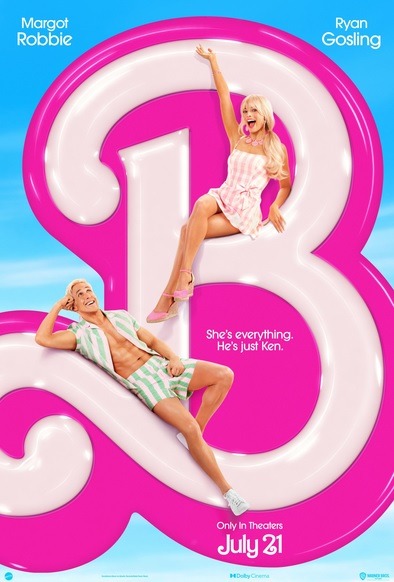
So last Tuesday (Aug 8th) we went to see The Barbie Movie. Now I wasn't a Barbie Girl growing up I had a hand full of dolls but I wasn't really into the whole Barbie thing as a kid I feel that I have more dolls in general now as an adult being I do collect alot of 1:6 Scale stuff of characters I like (mostly Lara Croft😁) and some of them are special edition Barbies. I just gravitated a lil more toward I guess you would say "boys toys" being I loved (and still do love) things like Star Wars, Transformer, Masters of the Universe, ect. I had tons of the She-Ra stuff to go with my He-Man 😄 Now my sister was a Barbie girl and had all the Barbie stuff and that is when I would mostly play Barbies on those rare moments when we weren't fighting and at each others throats. also yes there was of course collectable goodies for it and you can read all about that here.
Now as for the movie I thought it was going to be a lil weird, funny and silly and I wasn't wrong but it also had a very dramatic punch to it too but I can honestly say I did love it. I thought it was excellently done and felt it perfectly captured Barbie and her world.
The opening sequence where it is the 2001: A Space Odyssey parody that you see in the trailer is really good and it is a longer sequence and the voice over by Helen Mirren makes it even more funny and her narration through the entire movie is perfect and adds to the over all humor. Then after that you get to the actual main part of the movie and to Barbie Land and that were you are introduced to Margot Robbie's Barbie and everything she does I was like "this has to be in someone's imagination becasue this is exactly how you play"
but I would have to say the production design and everything was perfect! like when Ken (Ryan Gosling) gets "injured" and the whole "Doctor Barbie" thing with the fold out hospital was awesome!
The references,jokes and all the little things though the movie were awesome I had a few wide eyed gasps and plenty of smiles while watching this
The acting was I thought perfect everyone in this did an amazing job and Margot Robbie was perfect as Barbie (or stereotypical barbie as she is referred to in the movie) She was Barbie and I don't think anyone else could have done that better. Also Ryan Gosling as Ken (or I guess he would be stereotypical Ken/ Beach Ken) was perfect in this too! like I said everyone was amazing
The music is great and the Barbie dance number was really well done but the whole Ken dance number and follow-up Beach showdown/battle of the Kens I felt was just hilariously weird The song is really good but but that sequence in the movie is just purely hilariously weird
I thought it was funny were Mattel made fun of themselves as being this almost evil soulless corporation and everything being just grey and bland but when you went up to the boardroom everything was just pink and girly and they care about little girls dreams
Now when they get to the "real world" the movie does kinda hit differently it is still have the fun and silliness but at the same time you have a bit more of a seriousness and you do feel like you understand things a bit more. I can say that I felt that the movie did resonate with me alot and in various ways
There were moments were I totally could relate to Margot Robbie's Barbie on various levels and then also there were moments where I could totally relate to America Ferrera's character of Gloria on on various levels
I did kinda feel sorry for Ryan Gosling's Ken I was all "awww.." becasue he is so sad all he wants is to be noticed and loved by Margot Robbie's Barbie its like thats his purpose in life and he is trying so hard for that and she doesn't love him back it is kinda sad, so I kinda felt bad for him and felt his somewhat villain turn was kinda understandable becasue when they went to the real world he got love and respect from others but it was not the right kind but in the end when he come back to his senses that is all he wanted was the love and respect of Margot Robbie's Barbie.
In the end I thought it was excellently done and it is just a weirdly fun movie that you can enjoy. So I would highly recommend it. I really liked it and the ppl I went with did too we did a Girl's night for this one the boys didn't go. so we all like it.
There is no credits scenes but the credits did have an interesting lil animated thing where they showed alot of the dolls that inspired the movie.
#Barbie#Barbie Movie#Barbie Movie 2023#The Barbie Movie#Barbie The Movie#Barbie Doll#Mattel#Mattel Barbie#Barbie Mattel#Margot Robbie#ShannonJ286#NaughtyGirl286
4 notes
·
View notes
Text
Sometimes going on an adventure can soothe a restless soul. Lara (Revy?? Because I can’t escape it) is ready to take you with her. New exclusive drop tomorrow night. Officialautumnivy.com and a congratulations is in order if you find the artifact.


#autumn ivy#autumnivy#cosplayer#the bone collector#narrator#actor#costumer#amazon#alternative#cosplay#new content#exclusive#photoshoot#photoset#lara croft#tomb raider#outdoors#nature#muscle mommy#fit#muscular#tattoo#tattoed girls
228 notes
·
View notes
Text
Rules: name 10 of your favourite characters from 10 different fandoms, then tag 10 people to do the same.
Tagged by @brillemos, thank you! :o
I have a very select few one and only favorite favorite characters because I'm fickle and fall deeply in love w/ most characters but! Here are a few: new, newer, old, and very old. No particular order???
1. Discworld: Sam Vimes
2. Black Sails: Captain Flint (Miranda is a close 2nd w/ Silver trailing in 3rd)
3. Supernatural: Dean (Cas is the superior character imo, I just have the same bad taste he does lmao)
4. Tomb Raider: Lara Croft (finally playing the reboot and the crush I have is as bad as the crush I had as a child)
5. Dishonored: Billie and Corvo, please don't make me pick
6. Farseer Trilogy: The Fool
7. Lord of the Rings: Boromir and Faramir (followed closely by Eowyn and Eomir, tragic siblings ftw)
8. SVSS: Shen Yuan, my fav unreliable narrator.
9. FFVII: Aerith (I need time to play the remake asldjjdk)
10. WWDITS: Guillermo and Nadja
I feel like I'm probably forgetting several characters?? My brain is mush, please don't judge me.
Hi, it has been 84 years since I've tagged anyone: @airstyledraconos @snackerdoodle @skippydabeaver @tacomortal @shadowpeople @drivingsideways @thiswaycomessomethingwicked @coruscas @bcengine and anyone else who wants to.
3 notes
·
View notes
Text
Blog Post 1: Narratives
In this first blog post, I would like to inspect the nature of narratives in video games. I would also like to try finding my own definition of what a narrative is in the digital world of video games. In order to do that, I will have to refer to a few game creations that have been developed over the years and observe their narratives' structures, to then identify key components that would help differentiate them and set them apart.
Tomb Raider 2013

Generally speaking, this version of the game holds key aspects of a traditional narrative. First, the personality written for Lara Croft, the main character of the game is well believable and realistic. I remember from playing the game, how the plot shows a relatively steady development in Lara's character: she is first shown to be innocent and fearful as her adventures begin, and her decisions seem to be based on hesitation and uncertainty. Throughout the story, the main character ends up following a path of personal development and her actions start to reflect more logical decisions based on both her emotions and reason. All along she is accompanied and abandoned multiple times by a group of well-rounded side characters who both help her and ask for her aid at times. Not only does the narrative follow Bordwell and Thompson's three main components of time, space, and causation (Bordwell, Thompson, and Smith, 2023), but it also closes with a clear ending depicting a victory led by Lara and her friends who escape danger and return back to safety. Other than that, the narrative's structure that is adopted by the game designers seems to be linear, similar to the ones found in books and film, which is not surprising knowing that the first version of the game dates back to 1996 when it first debuted on the PS1 console. Even with the emersion of new versions, the game still limits player interactivity and control over the plot. The game can only be played the way the story was written, and its completion requires passing through all stages or events that are predefined.
Kena: Bridge of Spirits

Although this is a relatively fresh game produced by a new company, Kena: Bridge of Spirits follows a familiar narrative that can be identified in many older games. Its most notable nature comes in the shape of Levi-Strauss' theory which claims that most narratives have two main opposing characters (Strauss, 1963). In this case, there is an apparent contrast between light and darkness throughout the game. I remember from playing the game that the narrative does not focus on Kena's backstory, it instead gives priority to the battle between good and evil. Nonetheless, it is easy to identify with Kena since she represents "good" and most players can feel involved in her cause. Kena is a spirit guide, her mission is to free spirits that were trapped by evil throughout the villages in her world, and this was possible because of many interventions from NPCs (or side characters) who play a key role in helping her reach her goal. The narrative's structure in this game seems to resemble the string of pearls model where the storyline does have a clear beginning and ending, but its narration might slightly change between one player and another. This type of narrative allows players to venture on their own and engage in multiple side quests or paths before they end up at the designated ending stage. This exploration allows the player to be more in control of the game narrative, specifically in the temporal aspect of it as their actions specify how long the game takes to be completed.
The Witcher 3: Wild Hunt

Unlike the previous examples, this game offers a nuanced way of observing narratives in video games. It heavily relies on player interaction to determine the way the storyline progresses and even the way it ends. Although not the first of its type, The Witcher 3 remains one of the most well-known games that have a branching plot. Across all gameplay, the decisions that the main character Geralt takes affect the entire outcome and development of a lot of other characters (Millard, 2016). For instance, choosing how to respond to Ciri, his adoptive daughter, determines her future character. Choosing the types and the ways to interact with NPCs, and what sidequests to engage in, alters the entire storyline (Baker, 2022). Thus, making it impossible for all players to have the same linear progression of the game. This approach takes player engagement to the next level as interactions become the key components that drive the game's narrative.
And this brings me to the question...
How can I define a narrative?
Compared to conventional media like books and film, video games tend to have a much wider array of ways to go about writing narratives. Some games like Cities Skylines, a city-building simulation, don't even have any characters or stories prebuilt. Therefore, leaving it to the players to have the full creative freedom of creating imaginary plots and characters that fit their gameplay experience. In such instances, it becomes very difficult to give a clear definition of what a narrative is. In other instances, an entire game's narrative might be set on its environment or the emotions and feelings it exudes, like in the game Journey which is set on the exploration of the game world. Journey doesn't even provide linguistic dialogue between the player and the world entities. Only chirping sounds can be heard, which leaves it for the player to interpret the storyline. For these reasons, I believe it is crucial not to mix video games and other media when it comes to exploring narratives. Video game narratives cannot be confined to simple definitions as they come in an endless variety of forms. The only way to organize them is by classifying them in regard to their structures, or identifying whether the narrative is embedded or emergent when a storyline is available.
Sources
Bordwell D., Thompson K., and Smith J., 2023. Film Art: An Introduction ISE. [e-book] McGraw Hill. Available at: https://www.mheducation.co.uk/film-art-an-introduction-ise-9781265205478-emea-group [Accessed 6 Oct. 2023].
Strauss C.-L., 1963. Structural Anthropology. Translated by Jacobson C. and Schoepf B. G. Basic Books, Inc. New York. [pdf] Available at: https://monoskop.org/images/e/e8/Levi-Strauss_Claude_Structural_Anthropology_1963.pdf. [Accessed 6 Oct. 2023]
Millard D., 2016. The Narrative Structure of The Witcher 3. David Millard. [online] Available at: https://www.davidmillard.org/2016/12/the-narrative-structure-of-the-witcher-3/. [Accessed 6 Oct. 2023]
Stone C., 2019. The evolution of video games as a storytelling medium, and the role of narrative in modern games. Game Developer. [online] Available at: https://www.gamedeveloper.com/design/the-evolution-of-video-games-as-a-storytelling-medium-and-the-role-of-narrative-in-modern-games. [Accessed 6 Oct. 2023]
Tabari, M., 2021. Kena: Bridge of Spirits review — Familiar yet wonderful. [online] LaptopMag. Available at: https://www.laptopmag.com/reviews/kena-bridge-of-spirits [Accessed 6 OCt. 2023]
Baker, B., 2022. The Witcher 3: The 22 Most Important Choices You’ll Have To Make In The Game. [online] Game Rant. Available at: https://gamerant.com/witcher-3-most-important-choices/#pretending-to-capture-triss-amp-interrogating-menge [Accessed 6 Oct. 2023]
0 notes
Text
Comics I Read Today
August 8

Walt Disney’s Donald and Scrooge #2 (1992, Disney Comics)
Scrooge, Donald and the nephews are off to the Himalayans in search of the treasure of Genghis Khan! Once they the cross the perilous mountain, they find the lost city of Xanadu. As it turns out, Xanadu is known to them as Tralla La, a place they’ve been run out of before! This is a top notch comic in every respect, written and drawn by Don Rosa. It’s funny, exciting and respectful of the Duck legacy created by Carl Barks decades earlier.
My Rating: 10

Savage Dragon #15 (1994, Image)
Dragon has been infected by leeches that drive him crazy and he goes on a rampage through Chicago. He faces almost his entire cast of characters with enough exposition/narration that even a new reader understands what going on. Great, exciting art and story by Erik Larsen.
My Rating: 9

Blood of the Demon #14 (2006, DC)
Demon is being tortured by some real butt-ugly baddies. It’s bloody disgusting. Maiming the main character has never been a favorite trope of mine; some people (writers and artists) are just sadistic. Later elements in the story are interesting but I’ll pass on reading any more Demon stories. Video game ad for Lara Croft Tomb Raider Legend for PS2 and XBOX360.
My Rating: 4
1 note
·
View note
Text
@dcwnseeker / nathan drake "Birthday and Valentine's, all on the same day." Nate laughs; it's not the first time he's made that same statement, almost as regular as the day itself, and chances are he won't stop saying it. "A guy'd have to be some kinda lucky to spend a day like this with a lady like you." He raises his eyebrows as if waiting for an answer, but he doesn't leave her hanging, won't make her take that much initiative.
"Soo, if you'll say yes to being my Valentine-slash-birthday-partner, I have reservations to a that restaurant in the botanical gardens. I hear a walk through them afterwards is pretty nice to. It's no Perućica, but then again, what is?" Another laugh, and he lets out an, 'Oh!' as if just remembering something, then reaches into his jacket pocket and pulls out a package wrapped in brown paper and tied with twine. He isn't that good at wrapping, but Lara doesn't require neat packaging and a shiny bow to enjoy a gift. Inside is a moleskin journal and a case just big enough to hold two pencils and two pens. His favorite brand, what's seen him through more jobs, adventures, and lost cities than he can count.

It was Lara’s birthday! (2/14)
Lara tries to spend her birthday around her friends rather than wrapped up on some adventure in the middle of nowhere. Not that that hasn’t happened before, but she’s getting better about it, about being among the living and looking forward. That her birthday fell on the fabled Valentines Days (which could be traced back to a fertility pagan festival and wasn’t nearly as heavily commercialized) was rarely an issue for her these days. Romance wasn’t something that crossed her thoughts all that often.

“Careful, Nate,” she teased with a smile, “If I didn’t know any better that would sound like a date." She was sure there was someone else he could’ve spent today with, but instead she was monopolizing his time. As per usual. Lara couldn’t say she wasn’t happy about it, though.
The brown paper wrapped is easy enough to tear open, her fingers pulling at the twine until it gives. To be honest she likes the simple wrapping over the more extravagant kind. Once the moleskin journal is revealed, Lara smiled broadly and flipped through its blank pages, imagining all the adventures that would soon fill it. “I love it,” she replied, then looked back up at him. “And I accept being your Valentines-slash-birthday partner.” On instinct, she leaned over and placed a kiss on his cheek. Well, it was in the spirit of the day, or something like that.
#c: lara croft#dcwnseeker#dcwnseeker: nathan drake#answered#she's so dumb#i love her#narrator vc: she didnt know any better
0 notes
Note
On this note: "almost that entire series is told from an unabashedly female perspective." This is an interesting point to me. Of course marginalized creators in positions of creative control are valuable and important. Totally agree there. But could you elaborate on how this "unabashedly female perspective", as you put it, manifests in the actual narrative of the LoK series?
Oh, hello o/
Personally, the thing that always stood out most to me was the complete lack of sex and objectified females in the series (other than dumbass Umah in BO2 but we all know that game barely counts). That was almost unheard of in a video game back then. Instead the LoK world is a sexless utopia where highly emotional and eloquent men obsess over each other, stalk each other, commit passionate murder of each other. Raziel has his dick melted off before his story even begins. That always felt like a statement to me.
Afterwards, we always know what's in Raziel's heart and head. The game obsesses over his thoughts, his hopes, his despair, his bloodlust. He narrates in places that don't require narration, just so we know how he's feeling. He's perpetually being tossed around, manipulated, pursued, and put in vulnerable states by bigger, stronger men and monsters. Everyone wants him, or wants something from him. This is sexy. His tragic, quiet, Shakespearean death as Kain hovers over him in despair is supremely romantic. I hesitate to even say it because it feels like I'm revealing a dark secret that will turn boys off from enjoying them, but Ms. Hennig's LoK games are structured like an epic Boys Love (yaoi) story. Fights take the place of sex, but all other tropes are firmly in place.
Anyway, Soul Reaver was probably the first game I ever played that never had moments of sexism that took me out of it. Dealing with sexism is just something you have to do when you play video games. We all know this. But in Soul Reaver? No princess-rescuing, no one in a bikini (die, Umah), no female characters acting like idiots, cowards, bitches, or children all for the sake of building up the male protagonist.
Maybe the only way Ms Hennig was able to do this was by leaving ladies out entirely. Other than Ariel (whose face was half-skull), after Blood Omen there are no female characters (die Umah). Nevertheless, to me, female attitude and priorities pervaded the Soul Reavers and Defiance. I didn't need to see women characters in them to sense the woman holding the pen. When I did learn that a lady had written and directed them, I was not at all surprised. But that fact and her work were far, far more meaningful and influential to me than another Lara Croft or Aerith.
I hope that makes sense :)
77 notes
·
View notes
Text
Astute observation from the Homestuck Made This World discord:
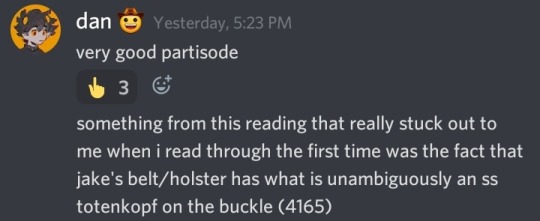
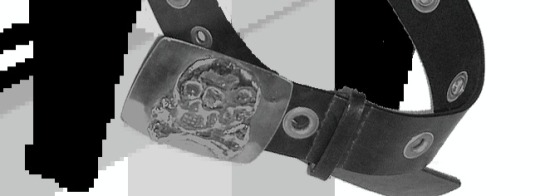
( It’s the Lara Croft buckle, the one from the Angelina Jolie movie )
The association with Jake makes this a good companion to Cronus's headscars, which form the jagged SS of the Schutzstaffel emblem. But in the same way that ICP being the alchemical fusion of Laurel & Hardy with Hitler was a way of encoding black culture as an Evil corrosive influence, I think this moment may be a homophobic (slash misogynistic?) encoding of Jake's adoption of a feminine signifier as evil, corrosive -- in addition to comparing himself to Jolie, it's the first mention of Jake's interest in shorter shorts, the apotheosis being the banana hammock that triggers Jade's traumatic memories and/or homophobia (or perhaps her trauma is just an unknowing cohort to the narration's homophobic spin? I'm honestly still somewhat murky on the extent to which this aspect of the metanarrative flows back into character psychology).
20 notes
·
View notes
Text
So I knew about the legend of the DA2 Japanese Dub, but I was today years old when I learned that Merrill was literally voiced by Pikachu and now I'm even sadder that this version of DA2 seems to be somehow lost to time forever.
I'm so fascinated with this, because no one is able to find anything about this Dub anymore, let alone a Japanese copy of the game, which only adds to its myth status, to a point where you question if it ever existed at all. 😂
One of the few hard evidence of its existence we still have is this single trailer, so I did a little bit of digging about the cast and apparently, the following people share the same Japanese VA (btw, this was literally how the names were spelled/romanized on the website that translated the credits):
Male Hawke and Justin Timberlake
Female Hawke and Ciri from Witcher 3
Varick (Varric) and Batista and Scooby-Doo
Bethany and Lara Croft
Meryl (Merrill) and Pikachu (also the little boy from The Shining)
Fenrisu (Fenris) and the talking Pikachu in Detective Pikachu (also the narrator from JoJo's Bizarre Adventure)
Anders and The Fantastic Mr. Fox
Cassandra “Knight Quest” and Bayonetta, Yennefer from Witcher 3 and Lara Croft (again)
Furemesu (Flemeth) and Disney’s Fairy Godmother, Grandmama in the Addams Family (and basically every elderly lady in everything ever)
The Arishoku and Carl from Up
Meredith and Sir Integra from Hellsing
Erushina (Elthina) and Dolores Umbridge
Reriana (Leliana) and Lara Croft (again)
Alistair and Leonardo DiCaprio
I hope this useless information brightened your day as much as mine.
#useless voice acting trivia is one of my favorite things ever <33#Merrill and Ikue Otani a match made in heaven#Merrill as Chopper and Aveline as Nami my fandoms finally collide lol#Hisako Kyoda for Flemeth is so friggin perfect as well <333#that little clip of her in the trailer actually gave me goosebumps#also half the cast is voiced by Lara Croft apparently#how many Lara Croft games are there? lol#language comparison#DA2 Japanese Dub#dragon age#da2#it took me a minute to figure out who ''Riandora'' was supposed to be#until I realized they meant Leandra lol#or ''Gamuren'' or ''Zaburan''
24 notes
·
View notes